Reflective Writing Task on Australian Engineering Practice ENEG20001
VerifiedAdded on 2021/05/27
|6
|1475
|21
Homework Assignment
AI Summary
This document presents a reflective writing assignment for the Australian Engineering Practice unit (ENEG20001) from Central Queensland University, focusing on the impact of engineering on society and engineering professionalism and ethics. The assignment explores the historical impact of engineering, categorizing its benefits into sustainability, cleanliness, safety, and connection, while also acknowledging negative consequences like destructive weapons and environmental issues. It further delves into engineering professionalism and ethics in the Australian context, emphasizing the importance of ethical conduct and adherence to Engineers Australia's code of ethics. The document discusses the positive and negative impacts of professionalism and ethics, highlighting their role in maintaining integrity and fostering responsible engineering practices. The solution includes a 'What Now?' section summarizing key takeaways and calls for responsible engineering practice. References from various academic sources are included to support the analysis.
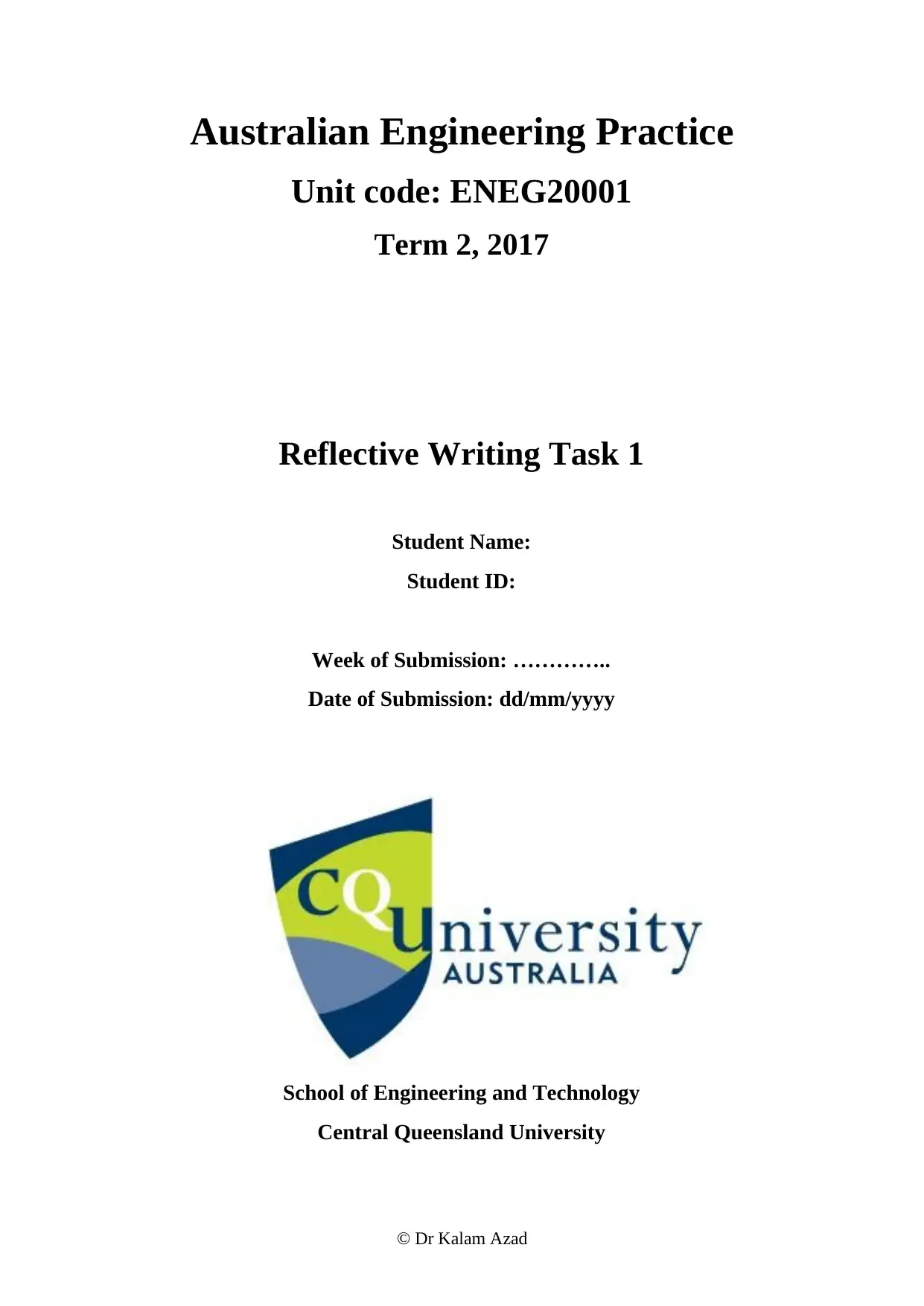
Australian Engineering Practice
Unit code: ENEG20001
Term 2, 2017
Reflective Writing Task 1
Student Name:
Student ID:
Week of Submission: …………..
Date of Submission: dd/mm/yyyy
School of Engineering and Technology
Central Queensland University
© Dr Kalam Azad
Unit code: ENEG20001
Term 2, 2017
Reflective Writing Task 1
Student Name:
Student ID:
Week of Submission: …………..
Date of Submission: dd/mm/yyyy
School of Engineering and Technology
Central Queensland University
© Dr Kalam Azad
Paraphrase This Document
Need a fresh take? Get an instant paraphrase of this document with our AI Paraphraser
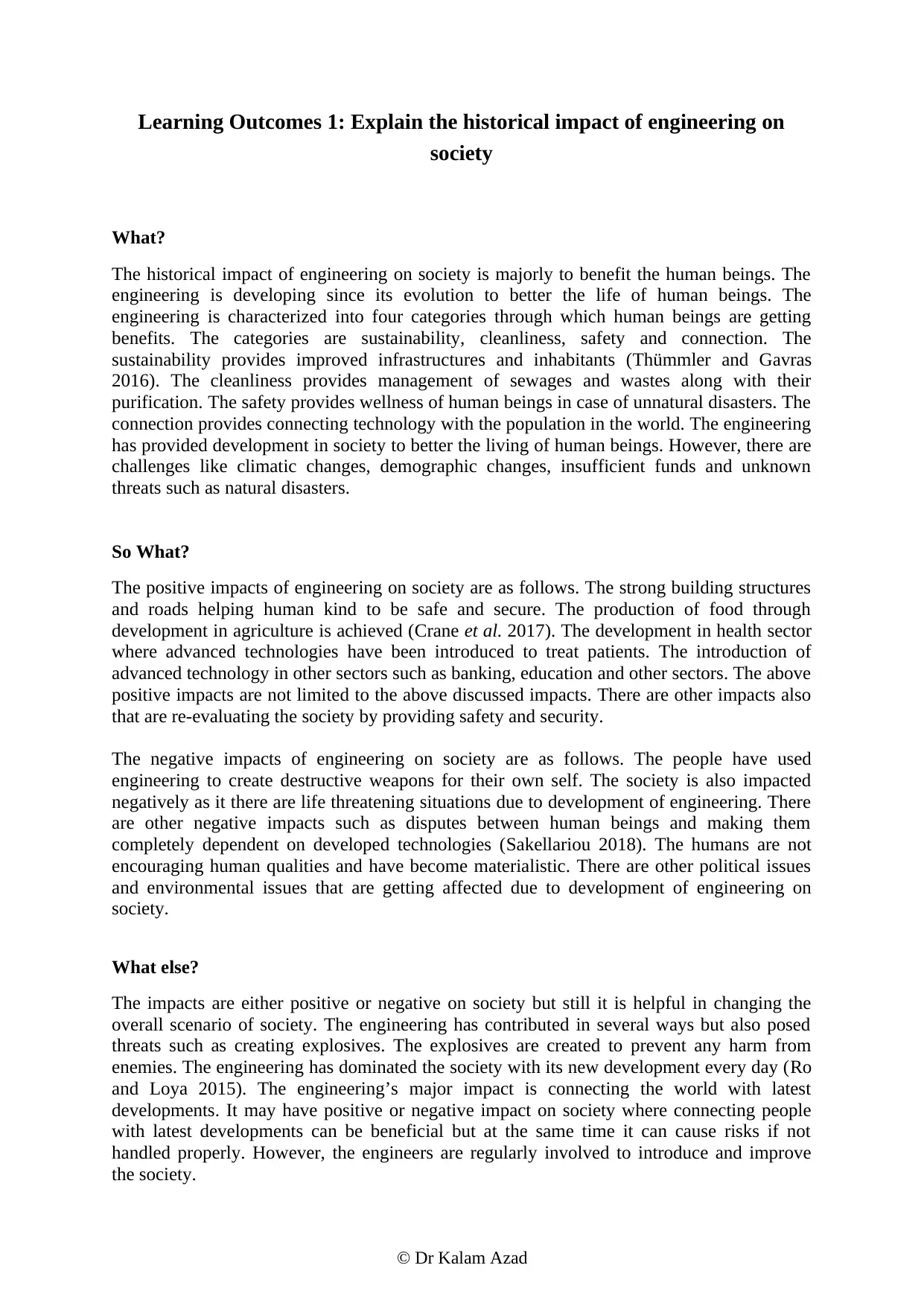
Learning Outcomes 1: Explain the historical impact of engineering on
society
What?
The historical impact of engineering on society is majorly to benefit the human beings. The
engineering is developing since its evolution to better the life of human beings. The
engineering is characterized into four categories through which human beings are getting
benefits. The categories are sustainability, cleanliness, safety and connection. The
sustainability provides improved infrastructures and inhabitants (Thümmler and Gavras
2016). The cleanliness provides management of sewages and wastes along with their
purification. The safety provides wellness of human beings in case of unnatural disasters. The
connection provides connecting technology with the population in the world. The engineering
has provided development in society to better the living of human beings. However, there are
challenges like climatic changes, demographic changes, insufficient funds and unknown
threats such as natural disasters.
So What?
The positive impacts of engineering on society are as follows. The strong building structures
and roads helping human kind to be safe and secure. The production of food through
development in agriculture is achieved (Crane et al. 2017). The development in health sector
where advanced technologies have been introduced to treat patients. The introduction of
advanced technology in other sectors such as banking, education and other sectors. The above
positive impacts are not limited to the above discussed impacts. There are other impacts also
that are re-evaluating the society by providing safety and security.
The negative impacts of engineering on society are as follows. The people have used
engineering to create destructive weapons for their own self. The society is also impacted
negatively as it there are life threatening situations due to development of engineering. There
are other negative impacts such as disputes between human beings and making them
completely dependent on developed technologies (Sakellariou 2018). The humans are not
encouraging human qualities and have become materialistic. There are other political issues
and environmental issues that are getting affected due to development of engineering on
society.
What else?
The impacts are either positive or negative on society but still it is helpful in changing the
overall scenario of society. The engineering has contributed in several ways but also posed
threats such as creating explosives. The explosives are created to prevent any harm from
enemies. The engineering has dominated the society with its new development every day (Ro
and Loya 2015). The engineering’s major impact is connecting the world with latest
developments. It may have positive or negative impact on society where connecting people
with latest developments can be beneficial but at the same time it can cause risks if not
handled properly. However, the engineers are regularly involved to introduce and improve
the society.
© Dr Kalam Azad
society
What?
The historical impact of engineering on society is majorly to benefit the human beings. The
engineering is developing since its evolution to better the life of human beings. The
engineering is characterized into four categories through which human beings are getting
benefits. The categories are sustainability, cleanliness, safety and connection. The
sustainability provides improved infrastructures and inhabitants (Thümmler and Gavras
2016). The cleanliness provides management of sewages and wastes along with their
purification. The safety provides wellness of human beings in case of unnatural disasters. The
connection provides connecting technology with the population in the world. The engineering
has provided development in society to better the living of human beings. However, there are
challenges like climatic changes, demographic changes, insufficient funds and unknown
threats such as natural disasters.
So What?
The positive impacts of engineering on society are as follows. The strong building structures
and roads helping human kind to be safe and secure. The production of food through
development in agriculture is achieved (Crane et al. 2017). The development in health sector
where advanced technologies have been introduced to treat patients. The introduction of
advanced technology in other sectors such as banking, education and other sectors. The above
positive impacts are not limited to the above discussed impacts. There are other impacts also
that are re-evaluating the society by providing safety and security.
The negative impacts of engineering on society are as follows. The people have used
engineering to create destructive weapons for their own self. The society is also impacted
negatively as it there are life threatening situations due to development of engineering. There
are other negative impacts such as disputes between human beings and making them
completely dependent on developed technologies (Sakellariou 2018). The humans are not
encouraging human qualities and have become materialistic. There are other political issues
and environmental issues that are getting affected due to development of engineering on
society.
What else?
The impacts are either positive or negative on society but still it is helpful in changing the
overall scenario of society. The engineering has contributed in several ways but also posed
threats such as creating explosives. The explosives are created to prevent any harm from
enemies. The engineering has dominated the society with its new development every day (Ro
and Loya 2015). The engineering’s major impact is connecting the world with latest
developments. It may have positive or negative impact on society where connecting people
with latest developments can be beneficial but at the same time it can cause risks if not
handled properly. However, the engineers are regularly involved to introduce and improve
the society.
© Dr Kalam Azad
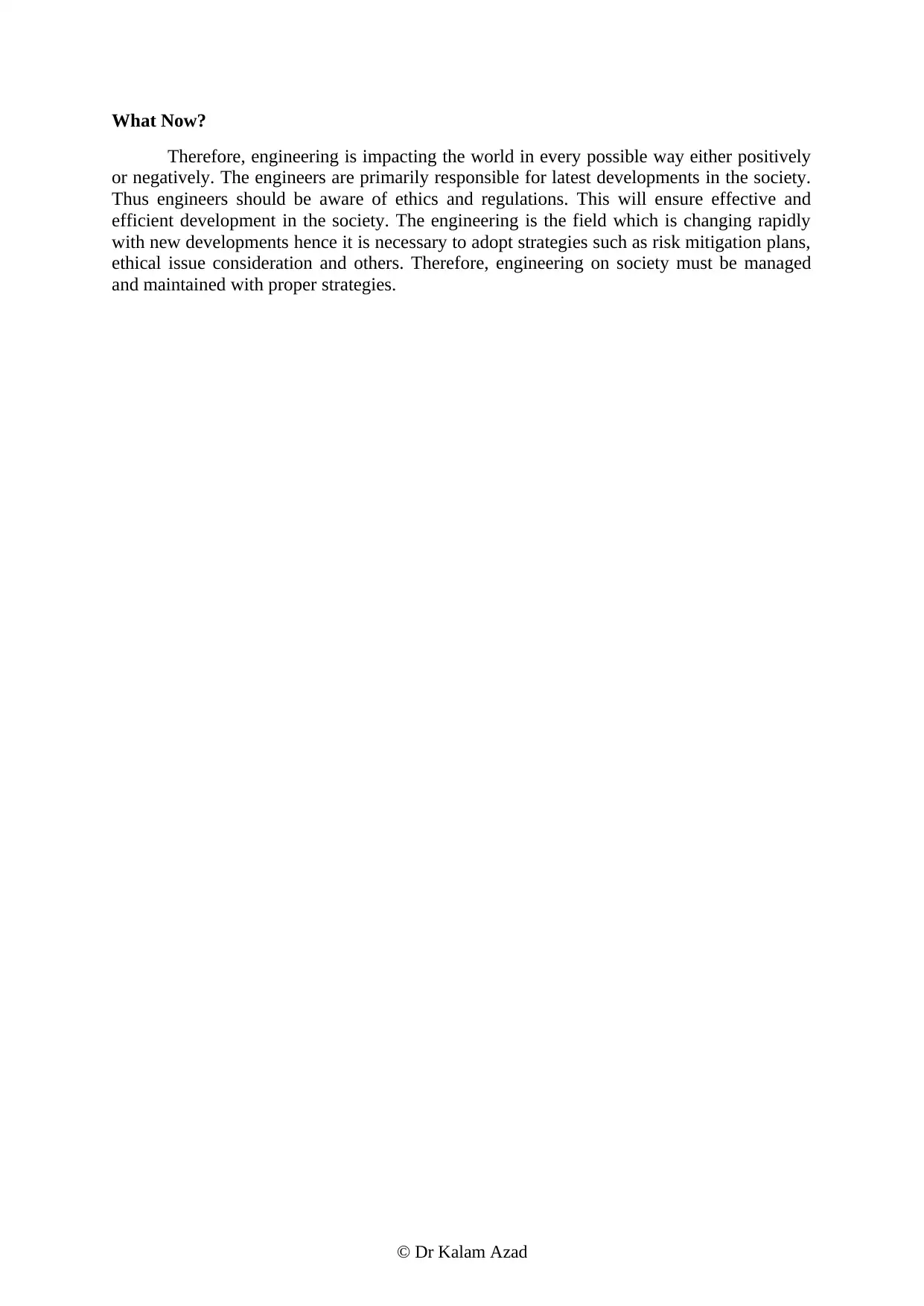
What Now?
Therefore, engineering is impacting the world in every possible way either positively
or negatively. The engineers are primarily responsible for latest developments in the society.
Thus engineers should be aware of ethics and regulations. This will ensure effective and
efficient development in the society. The engineering is the field which is changing rapidly
with new developments hence it is necessary to adopt strategies such as risk mitigation plans,
ethical issue consideration and others. Therefore, engineering on society must be managed
and maintained with proper strategies.
© Dr Kalam Azad
Therefore, engineering is impacting the world in every possible way either positively
or negatively. The engineers are primarily responsible for latest developments in the society.
Thus engineers should be aware of ethics and regulations. This will ensure effective and
efficient development in the society. The engineering is the field which is changing rapidly
with new developments hence it is necessary to adopt strategies such as risk mitigation plans,
ethical issue consideration and others. Therefore, engineering on society must be managed
and maintained with proper strategies.
© Dr Kalam Azad
⊘ This is a preview!⊘
Do you want full access?
Subscribe today to unlock all pages.

Trusted by 1+ million students worldwide
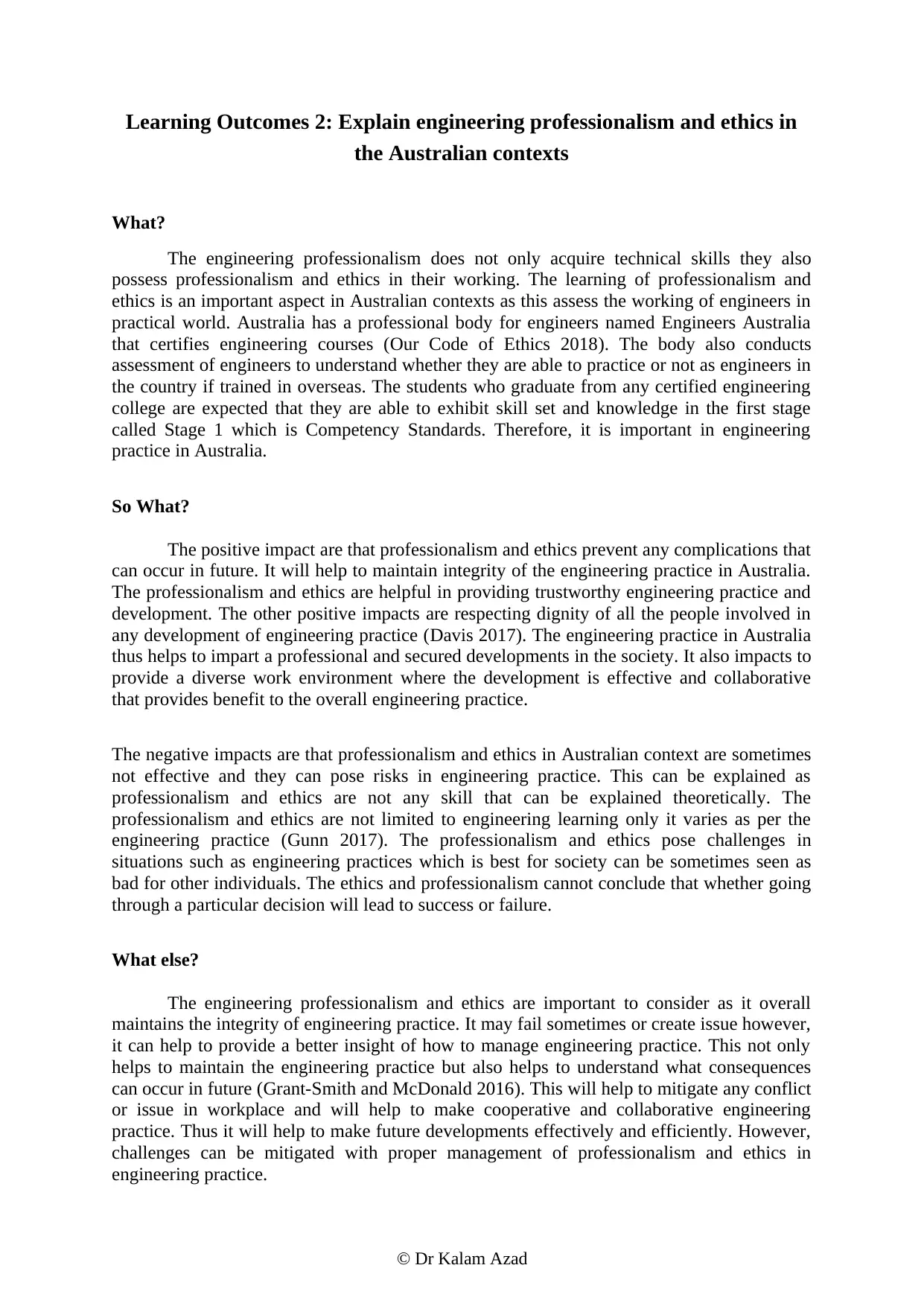
Learning Outcomes 2: Explain engineering professionalism and ethics in
the Australian contexts
What?
The engineering professionalism does not only acquire technical skills they also
possess professionalism and ethics in their working. The learning of professionalism and
ethics is an important aspect in Australian contexts as this assess the working of engineers in
practical world. Australia has a professional body for engineers named Engineers Australia
that certifies engineering courses (Our Code of Ethics 2018). The body also conducts
assessment of engineers to understand whether they are able to practice or not as engineers in
the country if trained in overseas. The students who graduate from any certified engineering
college are expected that they are able to exhibit skill set and knowledge in the first stage
called Stage 1 which is Competency Standards. Therefore, it is important in engineering
practice in Australia.
So What?
The positive impact are that professionalism and ethics prevent any complications that
can occur in future. It will help to maintain integrity of the engineering practice in Australia.
The professionalism and ethics are helpful in providing trustworthy engineering practice and
development. The other positive impacts are respecting dignity of all the people involved in
any development of engineering practice (Davis 2017). The engineering practice in Australia
thus helps to impart a professional and secured developments in the society. It also impacts to
provide a diverse work environment where the development is effective and collaborative
that provides benefit to the overall engineering practice.
The negative impacts are that professionalism and ethics in Australian context are sometimes
not effective and they can pose risks in engineering practice. This can be explained as
professionalism and ethics are not any skill that can be explained theoretically. The
professionalism and ethics are not limited to engineering learning only it varies as per the
engineering practice (Gunn 2017). The professionalism and ethics pose challenges in
situations such as engineering practices which is best for society can be sometimes seen as
bad for other individuals. The ethics and professionalism cannot conclude that whether going
through a particular decision will lead to success or failure.
What else?
The engineering professionalism and ethics are important to consider as it overall
maintains the integrity of engineering practice. It may fail sometimes or create issue however,
it can help to provide a better insight of how to manage engineering practice. This not only
helps to maintain the engineering practice but also helps to understand what consequences
can occur in future (Grant-Smith and McDonald 2016). This will help to mitigate any conflict
or issue in workplace and will help to make cooperative and collaborative engineering
practice. Thus it will help to make future developments effectively and efficiently. However,
challenges can be mitigated with proper management of professionalism and ethics in
engineering practice.
© Dr Kalam Azad
the Australian contexts
What?
The engineering professionalism does not only acquire technical skills they also
possess professionalism and ethics in their working. The learning of professionalism and
ethics is an important aspect in Australian contexts as this assess the working of engineers in
practical world. Australia has a professional body for engineers named Engineers Australia
that certifies engineering courses (Our Code of Ethics 2018). The body also conducts
assessment of engineers to understand whether they are able to practice or not as engineers in
the country if trained in overseas. The students who graduate from any certified engineering
college are expected that they are able to exhibit skill set and knowledge in the first stage
called Stage 1 which is Competency Standards. Therefore, it is important in engineering
practice in Australia.
So What?
The positive impact are that professionalism and ethics prevent any complications that
can occur in future. It will help to maintain integrity of the engineering practice in Australia.
The professionalism and ethics are helpful in providing trustworthy engineering practice and
development. The other positive impacts are respecting dignity of all the people involved in
any development of engineering practice (Davis 2017). The engineering practice in Australia
thus helps to impart a professional and secured developments in the society. It also impacts to
provide a diverse work environment where the development is effective and collaborative
that provides benefit to the overall engineering practice.
The negative impacts are that professionalism and ethics in Australian context are sometimes
not effective and they can pose risks in engineering practice. This can be explained as
professionalism and ethics are not any skill that can be explained theoretically. The
professionalism and ethics are not limited to engineering learning only it varies as per the
engineering practice (Gunn 2017). The professionalism and ethics pose challenges in
situations such as engineering practices which is best for society can be sometimes seen as
bad for other individuals. The ethics and professionalism cannot conclude that whether going
through a particular decision will lead to success or failure.
What else?
The engineering professionalism and ethics are important to consider as it overall
maintains the integrity of engineering practice. It may fail sometimes or create issue however,
it can help to provide a better insight of how to manage engineering practice. This not only
helps to maintain the engineering practice but also helps to understand what consequences
can occur in future (Grant-Smith and McDonald 2016). This will help to mitigate any conflict
or issue in workplace and will help to make cooperative and collaborative engineering
practice. Thus it will help to make future developments effectively and efficiently. However,
challenges can be mitigated with proper management of professionalism and ethics in
engineering practice.
© Dr Kalam Azad
Paraphrase This Document
Need a fresh take? Get an instant paraphrase of this document with our AI Paraphraser
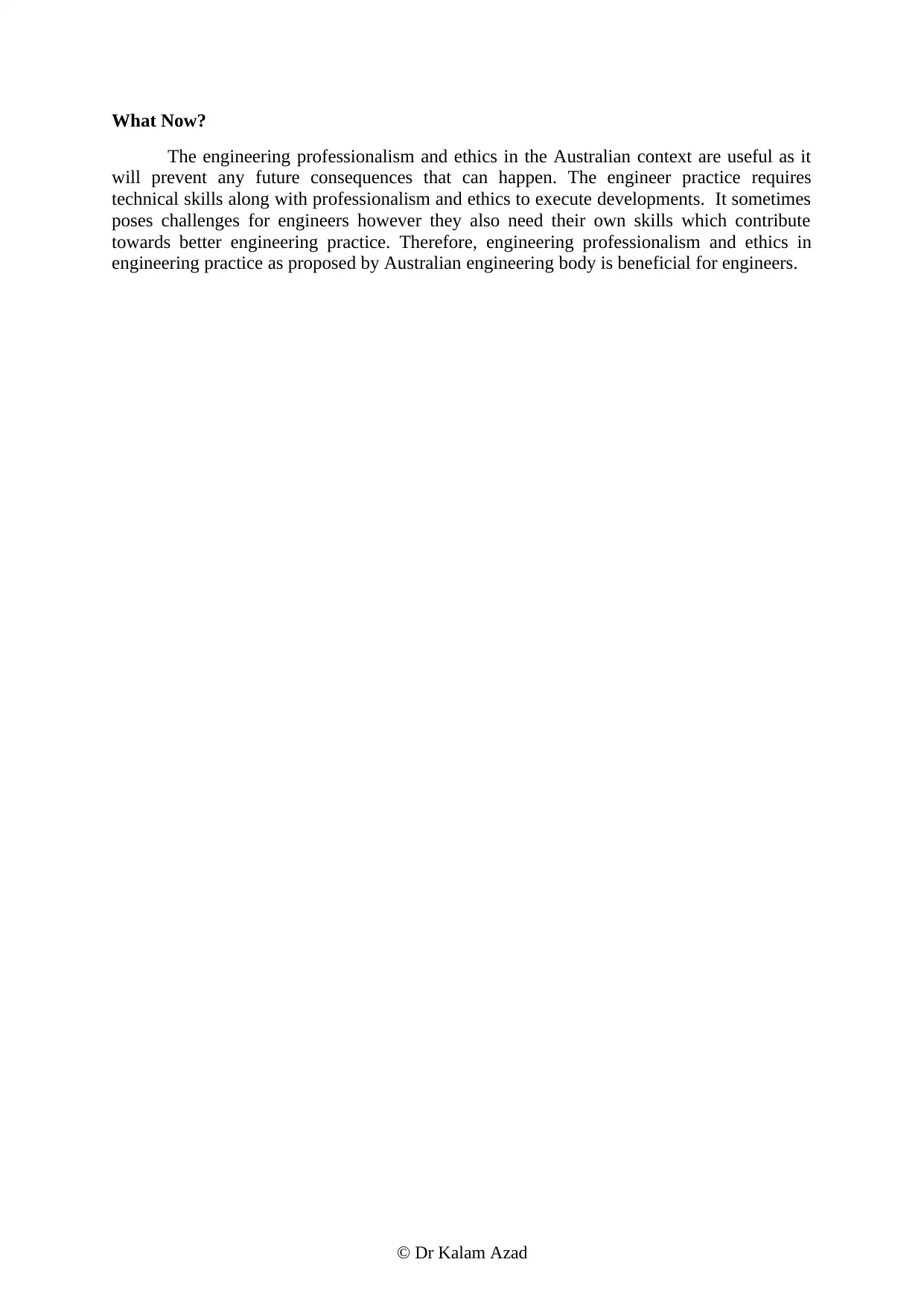
What Now?
The engineering professionalism and ethics in the Australian context are useful as it
will prevent any future consequences that can happen. The engineer practice requires
technical skills along with professionalism and ethics to execute developments. It sometimes
poses challenges for engineers however they also need their own skills which contribute
towards better engineering practice. Therefore, engineering professionalism and ethics in
engineering practice as proposed by Australian engineering body is beneficial for engineers.
© Dr Kalam Azad
The engineering professionalism and ethics in the Australian context are useful as it
will prevent any future consequences that can happen. The engineer practice requires
technical skills along with professionalism and ethics to execute developments. It sometimes
poses challenges for engineers however they also need their own skills which contribute
towards better engineering practice. Therefore, engineering professionalism and ethics in
engineering practice as proposed by Australian engineering body is beneficial for engineers.
© Dr Kalam Azad
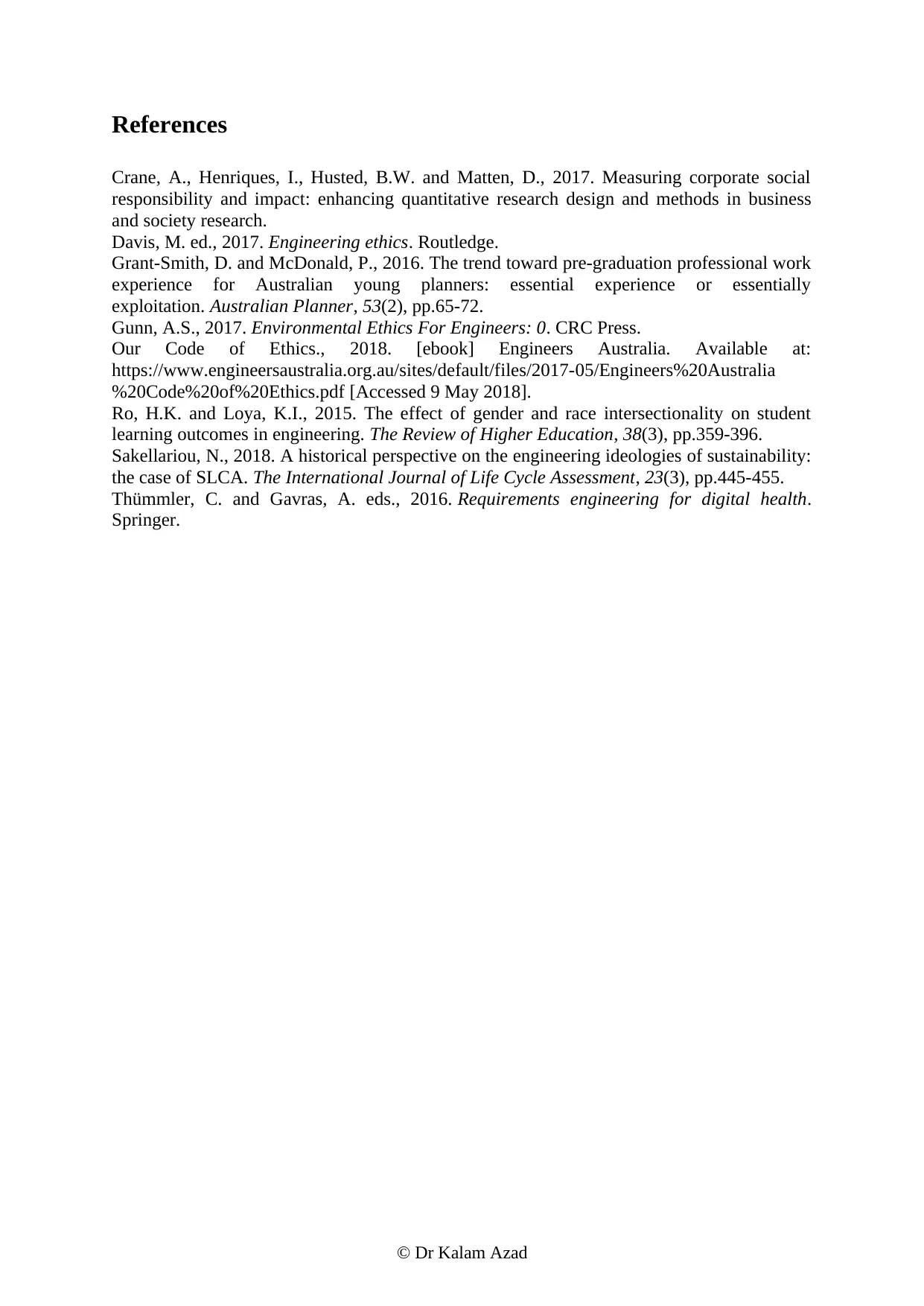
References
Crane, A., Henriques, I., Husted, B.W. and Matten, D., 2017. Measuring corporate social
responsibility and impact: enhancing quantitative research design and methods in business
and society research.
Davis, M. ed., 2017. Engineering ethics. Routledge.
Grant-Smith, D. and McDonald, P., 2016. The trend toward pre-graduation professional work
experience for Australian young planners: essential experience or essentially
exploitation. Australian Planner, 53(2), pp.65-72.
Gunn, A.S., 2017. Environmental Ethics For Engineers: 0. CRC Press.
Our Code of Ethics., 2018. [ebook] Engineers Australia. Available at:
https://www.engineersaustralia.org.au/sites/default/files/2017-05/Engineers%20Australia
%20Code%20of%20Ethics.pdf [Accessed 9 May 2018].
Ro, H.K. and Loya, K.I., 2015. The effect of gender and race intersectionality on student
learning outcomes in engineering. The Review of Higher Education, 38(3), pp.359-396.
Sakellariou, N., 2018. A historical perspective on the engineering ideologies of sustainability:
the case of SLCA. The International Journal of Life Cycle Assessment, 23(3), pp.445-455.
Thümmler, C. and Gavras, A. eds., 2016. Requirements engineering for digital health.
Springer.
© Dr Kalam Azad
Crane, A., Henriques, I., Husted, B.W. and Matten, D., 2017. Measuring corporate social
responsibility and impact: enhancing quantitative research design and methods in business
and society research.
Davis, M. ed., 2017. Engineering ethics. Routledge.
Grant-Smith, D. and McDonald, P., 2016. The trend toward pre-graduation professional work
experience for Australian young planners: essential experience or essentially
exploitation. Australian Planner, 53(2), pp.65-72.
Gunn, A.S., 2017. Environmental Ethics For Engineers: 0. CRC Press.
Our Code of Ethics., 2018. [ebook] Engineers Australia. Available at:
https://www.engineersaustralia.org.au/sites/default/files/2017-05/Engineers%20Australia
%20Code%20of%20Ethics.pdf [Accessed 9 May 2018].
Ro, H.K. and Loya, K.I., 2015. The effect of gender and race intersectionality on student
learning outcomes in engineering. The Review of Higher Education, 38(3), pp.359-396.
Sakellariou, N., 2018. A historical perspective on the engineering ideologies of sustainability:
the case of SLCA. The International Journal of Life Cycle Assessment, 23(3), pp.445-455.
Thümmler, C. and Gavras, A. eds., 2016. Requirements engineering for digital health.
Springer.
© Dr Kalam Azad
⊘ This is a preview!⊘
Do you want full access?
Subscribe today to unlock all pages.

Trusted by 1+ million students worldwide
1 out of 6
Related Documents
Your All-in-One AI-Powered Toolkit for Academic Success.
+13062052269
info@desklib.com
Available 24*7 on WhatsApp / Email
![[object Object]](/_next/static/media/star-bottom.7253800d.svg)
Unlock your academic potential
Copyright © 2020–2025 A2Z Services. All Rights Reserved. Developed and managed by ZUCOL.




